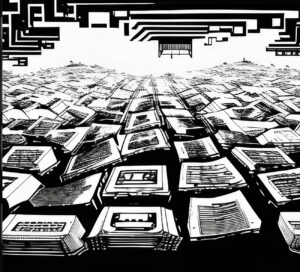Hatched Episode 1: All About Web3
In this first episode of Hatched, host Glycel sits down with Aman to delve into the exciting and rapidly evolving world of Web3, blockchain, cryptocurrency, and NFTs. With years of experience in the industry, Aman provides unique insights and valuable perspectives on this cutting-edge technology and its potential impact on the future.
If you’re new to the topic, this conversation is sure to broaden your understanding and spark your interest in the world of Web3 and beyond. So sit back, relax, and join us for this exciting episode.
You can also check out the full video version of this episode!
What is Web3?
The word Web3 is a concept that blanket describes the blockchain, crypto, NFT, and DeFi industry. It’s meant to be the next iteration of the Internet. The first iteration was Web1, which was read only, meaning a small group of people publish content and large groups of people consume that content. Web2 is read and write, people publish content, consume and engage with the content, which is facilitated by big tech companies.
And then Web3 is read, write, execute, and earn. Web3 is trying to make it so that a lot more of these functions are done by trustless peer-to-peer networks.
“Users have more power, autonomy, and higher ability to actually earn based on their consumption.”
What is a peer-to-peer network?
Blockchains that run on a computer network that’s distributed all over the world are run by its participants. There’s no centralized entity inside these peer-to-peer networks or blockchains to dictate what happens on the chain.
Blockchain in itself is a digital ledger. That’s it. It’s blocks of information and there are different ways you can add a block to a chain based on the network itself. The point is that there’s a system of computers that can process transactions without one controlling entity and can make sure that the transaction records are never altered and are immutable.
What’s the difference between blockchain and crypto?
Blockchain is the means of recording. If I send you money that’s recorded in a block on the chain, the thing that I’m sending you is the crypto. That token is the thing that is being used to exchange value and that exchange is being recorded on the blockchain.
There are public blockchains. Are there also private blockchains?
Yes. Public blockchains are peer-to-peer, decentralized distributed, so that there’s no single entity that can take over a network.
Private blockchains are usually enterprise blockchain. It can be done in banking, supply chain management, but usually it’s one company that sets up their own blockchain. They’re in control of the distribution of that ledger and they are in control of what can be altered on the ledger.
With public chains, because there’s so many distributed nodes and they’re all different entities, you would need 51% of the network to agree to a change before you could actually make a change.
Can you explain what proof-of-work and proof-of-stake is?
Proof-of-work and proof-of-stake are consensus mechanisms. They are methods in which the computers running the blockchain come to the same agreement on what the state of the chain is.
In proof-of-work (Bitcoin and formerly Ethereum), each participant is a miner. They set up complex computer rigs which solve very complicated mathematical problems. And the first computer to solve it is the one that gets to propose the block and validate the block and add it to the chain. Then, it’s confirmed by all the other miner nodes in the network. You are then, as the miner, rewarded some Bitcoin and transaction fees. This method is super secure because in order to take over 51% of the network, to do anything malicious, you would need an insane amount of computational power. It’s very energy intensive, but it’s very secure.
Proof-of-stake, on the other hand, is meant to make it environmentally-friendly, more scalable, and more open for access. In this method, you stake tokens into a smart contract to become a validator, to validate the block. Those tokens are the collateral the network has on you to act honestly. If you act maliciously (which is described by the network rule), those tokens are burned, so you lose the money you stake. It’s putting up money to earn money.
What is DeFi?
DeFi is the recreation of the traditional financial system in peer-to-peer distributed networks. It’s trying to make it so that all these financial transactions we do in the normal traditional world, such as sending money to one another, taking out loans, lending money, the liquidity pools, all these kinds of things that happen in a traditional bank or any of these things we created, but in peer-to-peer.
Instead of a bank loaning me money or me giving my money to the bank and storing it for them to load it out, I am in control of that. It’s meant to eliminate the middlemen making the most money off of all of this, which are the banks.
In DeFi, these transactions are facilitated by an application or a protocol. They make small transaction fees and things like that. It’s meant to be a much more honest way to do finance and an alternative to what already exists.
What are Non-fungible Tokens?
NFTs are tokenized forms of data. Most people know it as Bored Apes, CryptoPunks, and art that for some reason, most people don’t understand why it has value. But really, it stands for non-fungible token, which is a unique token that represents a piece of data.
NFTs are created on blockchains as unique tokens, so that you can monetize your data. And it’s not just pictures, it can be videos, books, land titles, degrees, your healthcare data, your browser data, any sort of data that you can envision. You can go to any platform and mint this data, which means you’re registering it on the blockchain. And you’re creating the token inside the ecosystem and then storing the data.
“It’s opening up liquidity for your data itself. And that’s why I’m very very bullish on NFTs as a use case. Maybe not in the current state that they’re in, but in a lot of other different industries.”
Why are NFTs such a big deal?
Previously, we didn’t have ways to create tangible value out of data on behalf of individuals. If I have my healthcare records, for example, I can’t go to a big pharmaceutical company and sell my healthcare records so that I can make some money.
In Web3, what we’re trying to do is tokenize that data so that data has value. I can add that to a pool of other people’s healthcare data, then a pharmaceutical company buys the rights to use that data for a set of research. The money that’s earned is put into a smart contract and distributed to all the people that contributed their healthcare data.
If you really understand what that means, you start to imagine anything you do, or any information you have can be tokenized and sold. Someone will find it useful, whether it’s healthcare, search history for advertisers, university degrees… and it’s immutable. It means, it can never be changed.
What are the biggest challenges in the crypto ecosystem?
Regulations
I would rather there’s no clear regulations happening right now so that we can move forward with it.
“The problem is that a lot of the people putting forth the regulation don’t really understand the industry, so they don’t understand what needs to be regulated.”
Because of that, they’ll probably come up with bad regulations that aren’t really protecting consumers. My biggest concern is that the people in charge don’t really understand it. But I welcome regulations. I just want it to be educated.
User onboarding
There’s still too much of an educational requirement to enter the space. You can learn, but that’s insane.
“We can’t expect an average person to want to learn about all these things, to use this technology or benefit from it. We have to make UI UX simpler, make all these things much easier to use so that people can get actual value from them. And not ignored because it’s too complicated.”
That’s the only way that we get massive adoption. If I buy an NFT ticket to a festival, I don’t care if it’s an NFT. If there are benefits for the actual technology side of it, meaning less fraud, we have royalties for the artist, or whatever. Great! but I don’t care. No one has to learn this stuff. That’s when we will really start going is when we start building things where the value is given to end users, but they don’t need to understand it. That’s how I see us moving forward.
What impact do you think the crypto ecosystem has on the world in the future?
Crypto is very effective for transferring value in borderless digital ecosystems. It makes that really easy. Me sending you Bitcoin today is so much easier than me sending you US dollars, or Hong Kong dollars, or Singapore dollars. It also opens up not just mobilization of money, but also sale of data internationally, and all these kinds of things. It opens up your economy worldwide globally, without it being a physical globalization, just digital globalization.
For NFTs, it’s data tokenization, data-as-an-asset is what we call it at NEST®, it’s the ability to create a token representation of any data you want and sell that.
“That opens up a lot of monetization potential for everyone, specifically for people in developing countries.”
Closing
We hope you found this Episode of Hatched to be informative. The world of Web3 is constantly evolving, and there’s always more to learn and discover.
Be sure to keep an eye out for the next episode of Hatched, we will continue to delve into these topics every two weeks. Until then, thank you for joining us and we look forward to your continued support!





